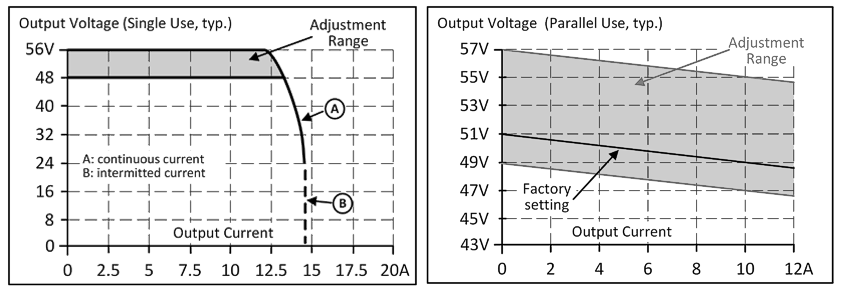Output
The output provides an SELV/PELV/ES1 nominal voltage that is electrically isolated from the input voltage.
The device is designed to supply any type of load, including capacitive and inductive loads. If very large capacitors, such as EDLCs (electrical double-layer capacitors or "UltraCaps") with a capacitance > 0.25F are connected to the output, the device can charge the capacitor intermittently.
The output is electronically protected against overload, no-load and short circuit. In the event of a protection event, audible noises may occur
Output voltage | Nom. | 48V |
|
Adjustment range | Min. | 48-56V | Guaranteed value |
Max. | 60V | This is the maximum output voltage that can occur in the end position of the potentiometer in clockwise direction due to tolerances. It is not a guaranteed value that can be achieved. | |
Factory settings
| Typ. | 48.0V | ±0.2%, single use at full load (cold device) |
Typ. | 47.0V | ±0.2%, parallel use at 10A (cold device) | |
Line regulation | Max. | 10 mV | Between 85 and 300Vac |
Load regulation | Max. | 150 mV | Between 0 and 10A, static value, "single use" |
Typ. | 2000 mV | Between 0 and 10A, static value, "parallel use", see Fig. Output voltage over output current (parallel use) typ. | |
Residual ripple and ripple voltage | Max. | 50mVSS | Bandwidth 20 Hz to 20 MHz, 50 Ohm |
Output current | Nom. | 12A1) | At 48 V and ambient temperature below 45°C |
Nom. | 10A | At 48 V and 60°C ambient temperature | |
Nom. | 7.5A | At 48 V and 70°C ambient temperature | |
Nom. | 10.3A1) | At 56 V and ambient temperature below 45°C | |
Nom. | 8.6A | At 56 V and 60°C ambient temperature | |
Nom. | 6.5A | At 56 V and 70°C ambient temperature | |
Linear derating between +45°C and +70°C | |||
Safety | Typ. | 30A | Up to 12ms once every five seconds, see Fig. Dynamic output current capacity, typ. |
Overload behavior |
| Continuous current | Output voltage > 26Vdc, see Fig. Output voltage over output current, typ. |
| Hiccup mode 2) | Output voltage < 26Vdc, see Fig. Output voltage over output current, typ. | |
Short circuit current | Max. | 14.8A | Continuous current, see Fig. Output voltage over output current, typ. |
Typ. | 15A | Intermittent current peak value for typ. 2s | |
max | 4.7A | RMS value of the current, | |
Output capacity | Typ. | 2500μF | Included in the power supply |
Load feedback | Max. | 63V | The device is resistant to load feedback and will not indicate a malfunction if a load is feeding voltage back into the power supply. It does not matter whether the power supply is switched on or off. The absorbed energy can be determined by means of the built-in large-size output capacitor. |
1) This current is also available for temperatures up to +70°C with a duty cycle of 10% and/or no more than 1 minute every 10 minutes.
2) In the event of heavy overload (when the output voltage drops below 13V), the power supply provides continuous output current for 2s. The output is then switched off for about 18 seconds before a new switch-on attempt is automatically made. This cycle is repeated as long as the overload persists. After the overload has been rectified, the device will operate normally. See Fig. Short circuit at output, hiccup mode, typ.

